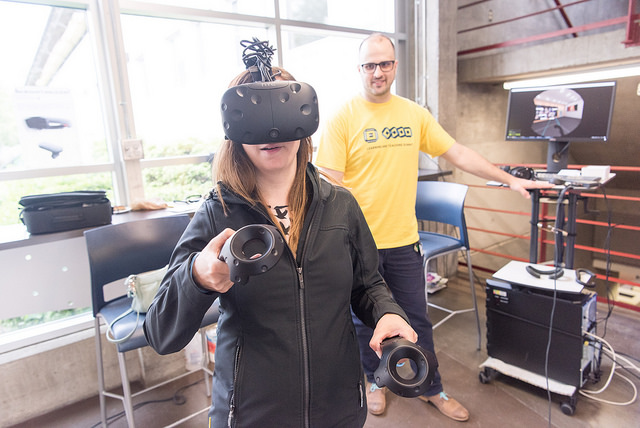[Feature Article] BCIT Learning and Teaching Centre’s Emergent Virtual Reality Strategy
Contributed by Bonnie Johnston, BCIT.
There’s a lot of buzz in the advanced education world around Virtual Reality/Augmented Reality as the technology moves along the hype cycle. A lot of us are wondering what effort and investments are required to have good value in terms of supporting meaningful learning.
At BCIT’s Learning and Teaching Centre, getting our hands on the equipment has happened quicker than getting our heads around the learning value, development processes, and sustainable support practices. By circumstance, our strategy is emergent. We are tapping into our teams’ existing expertise to figure it out.
Here is where we are at:
The MediaWorks team is housed in the Burnaby Library. They support students and instructors directly with DIY media development. They now have a Microsoft HoloLens set up so that students and instructors can come in and have some hands-on practice with the technology. The team also supports students and instructors install software applications as needed.
If instructors want to have more hands-on familiarization or want to explore specific topics using existing applications, our team in Education Technology Services can help them. The team is also reaching out to programs at all of BCIT’s campuses, going on site to demonstrate the different technologies. The technologies we have on hand are a Microsoft HoloLens, an HTC-VIVE virtual reality system, and accessing web-based apps with a cardboard viewer attached to a mobile phone. With this outreach, the idea is to plant ideas in our instructors’ heads about potential learning needs that might be met.
For example, a demonstration with the Prosthetics and Orthotics program involved using an off-the-shelf product, 3D Organon VR Anatomy and the HTC-VIVE with an instructor and his class of 15 students. Because only one person at a time could use the viewer, the instructor needed to design a learning activity to keep all of the students engaged. They sat in a circle that was bordered by large screens. One-by-one, each student took a turn with the device and attempted to take apart pieces of anatomy in the correct order that would be appropriate for applying a prosthetic device. The other students watched the immersed student’s progress on the screens and gave feedback to the immersed student. So, like many other expensive technologies, limiting the resources requires thinking about designing an activity in such a way that all students are engaged. Deploying 3D via a web-based application so that all students can participate with their personal mobile device gets the experience into everybody’s hands simultaneously, but with a loss of the full immersion experience.
The LTC uses a project-based approach to develop custom learning materials. As we engage with the programs and faculty, we will begin to scope potential projects for creating new media for the virtual environment. Instructional Development Consultants come to ideas with a pedagogical lens, working with faculty on what the intended learning outcome would be and whether virtual reality is the right solution. The IDC then works on the design of the activity with the instructor and manages the development. 
A project could determine the best path would be to use 360-degree video assets for the virtual environment. The LTC’s team of Media Producers have recently purchased an Insta360 Pro which can create high resolution stills and video, live streaming video, and can record in 360-degree audio as well. Stitching is done within the camera. The team is currently in the learning phase by working on a small project where they are creating a virtual campus tour for BCIT’s Marketing department. One area we are fully exploring are the various considerations needed to decide whether to deploy the experience integrated into the Unity platform or would it be better to be a stand-alone video via the web.
If the project determines that the environment needs to be constructed, our new Virtual Simulation Team is resourced with a Graphic Artist, Simulation Asset Artists, and Multimedia Developers who will create it from scratch. Working with the Unity platform, the team has started discovering the challenges ahead by re-using simulated 3D media developed for the screen to the VR environment. Specifically, they’ve taken a 3D simulation they created for an auto transmission, a demo interactivity where students can re/assemble parts, and readied it for the virtual environment. Some of the team are currently working closely with the School of Health Sciences on virtual patient assessment simulations.
While we are always mindful that we want to be strategic about where we put our efforts, taking an emergent-mindset to moving forward with VR/AR allows us to make room for learning and exploring because we’re not pretending we have all the answers.

